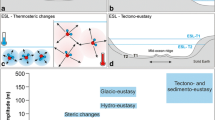Abstract
The effect of spray droplets in the marine surface layer on evaporation is considered. Independent evidence from energy constraints, from visibility and from sea salt content of air is used. The estimation shows that, except perhaps for hurricane wind strength, the increase of total evaporation from evaporating droplets is negligible. This is in agreement with recent experimental evidence.
Similar content being viewed by others
References
Bortkovskii, R. S.: 1987,Air Sea Exchange of Heat and Moisture During Storms, D. Reidel, Dordrecht, 194 pp.
Chamberlain, A. C.: 1983, ‘Roughness Length of Sea, Sand, and Snow’,Boundary-Layer Meteorol. 25, 405–409.
DeCosmo, J.: 1991, ‘Air-Sea Exchange of Momentum, Heat and Water Vapor Over White Cap Sea States’, Dissertation Department of Atmospheric Science, University of Washington, Seattle, 212 pp.
DeLeeuw, G.: 1990, ‘Profiling of Aerosol Concentrations, Particle Size Distributions and Relative Humidity in the Atmospheric Surface Layer Over the North Sea’,Tellus 42B, 342–354.
Edson, J. B.: 1989, ‘Lagrangian Model Simulation of the Turbulent Transport of Evaporating Jet Droplets’, Ph.D. thesis, Pennsylvania State University.
Isemer, H.-J. and Hasse, L.: 1987,The Bunker Climate Atlas of the North Atlantic Ocean. Vol. 2: Air-Sea Interactions, Springer-Verlag Berlin, 252 pp.
Junge, C. E.: 1963,Air Chemistry and Radioactivity, Academic Press New York, 382 pp.
Katsaros, K. B., Smith, S. D. and Oost, W. A.: 1987, ‘HEXOS-Humidity Exchange Over the Sea. A Program for Research on Water Vapor and Droplet Fluxes from Sea to Air at Moderate to High Wind Speeds’,Bull. Am. Meteorol. Soc. 68, 466–476.
Kruspe, G.: 1977, ‘On Moisture-Flux Parametrization’,Boundary-Layer Meteorol. 11, 55–63.
Ling, S. C., Saad, A. and Kao, T. W.: 1978, ‘Mechanics of Multiphase Fluxes Over the Ocean’, in Favre and Hasselmann (eds.),Turbulent Fluxes Through the Sea Surface, Wave Dynamics and Prediction, Plenum, New York, pp. 185–197.
Mestayer, P. G., Monahan, E. C. and Beetham, P. A. (eds.): 1990,Modelling the Fate and Influence of Marine Spray, Marine Sci, Inst. Groton, Connecticut, pp. 174.
Rouault, P., Mestayer, P. G. and Schiestel, R.: 1991, ‘A Model of Evaporating Spray Droplet Dispersion’,J. Geophys. R. 96C4, 7181–7200.
Smith, S. D.: 1989, ‘Water Vapor Flux at the Sea Surface’,Boundary-Layer Meteorol. 47, 277–293.
Smith, S. D.: 1990, ‘Influence of Droplet Evaporation on HEXOS Humidity and Temperature Profiles’, Appendix to Mestayer, Monahan and Beetham (eds.),Modelling the Fate and Influence of Marine Spray, Marine Science Institute, Groton, Connecticut.
Twomey, S.: 1977,Atmospheric Aerosols, Developments in Atmospheric Science 7, Elsevier, Amsterdam, 302 pp.
Author information
Authors and Affiliations
Rights and permissions
About this article
Cite this article
Hasse, L. On the contribution of spray droplets to evaporation. Boundary-Layer Meteorol 61, 309–313 (1992). https://doi.org/10.1007/BF02042938
Accepted:
Issue Date:
DOI: https://doi.org/10.1007/BF02042938




